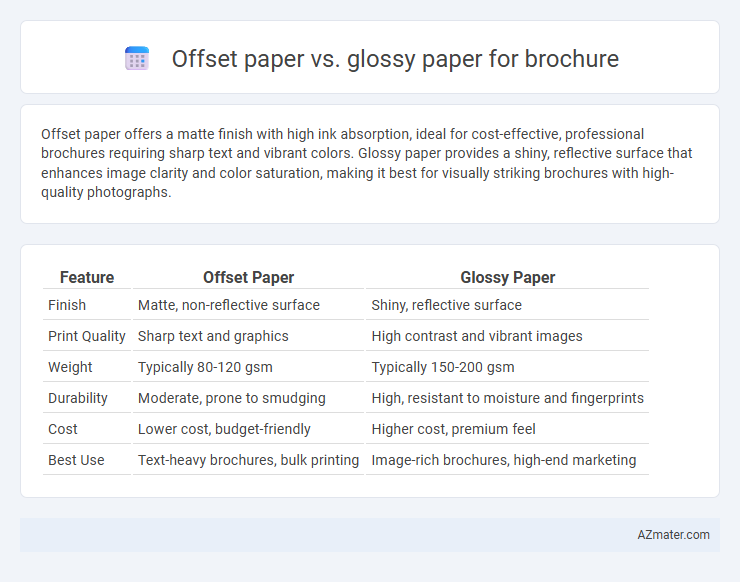Offset paper offers a matte finish with high ink absorption, ideal for cost-effective, professional brochures requiring sharp text and vibrant colors. Glossy paper provides a shiny, reflective surface that enhances image clarity and color saturation, making it best for visually striking brochures with high-quality photographs.
Table of Comparison
| Feature | Offset Paper | Glossy Paper |
|---|---|---|
| Finish | Matte, non-reflective surface | Shiny, reflective surface |
| Print Quality | Sharp text and graphics | High contrast and vibrant images |
| Weight | Typically 80-120 gsm | Typically 150-200 gsm |
| Durability | Moderate, prone to smudging | High, resistant to moisture and fingerprints |
| Cost | Lower cost, budget-friendly | Higher cost, premium feel |
| Best Use | Text-heavy brochures, bulk printing | Image-rich brochures, high-end marketing |
Introduction to Brochure Paper Types
Offset paper offers a smooth, matte finish ideal for brochures requiring high print clarity and durability, commonly used in commercial printing due to its cost-effectiveness and excellent ink absorption. Glossy paper provides a shiny, reflective surface that enhances color vibrancy and image sharpness, making it perfect for visually striking brochures aimed at grabbing attention. Choosing between offset and glossy paper depends on the brochure's purpose, desired aesthetic, and budget constraints, with offset favoring professional, understated designs and glossy appealing to vibrant, high-impact marketing materials.
What is Offset Paper?
Offset paper is a high-quality, uncoated paper commonly used in commercial printing, offering excellent ink absorption and a matte finish ideal for detailed text and images. It provides a smooth surface that enhances color accuracy and legibility, making it well-suited for brochures requiring a professional and elegant look. Unlike glossy paper, offset paper reduces glare, ensuring readability and a sophisticated tactile experience.
What is Glossy Paper?
Glossy paper features a shiny, reflective surface achieved through a coating process that enhances color vibrancy and image sharpness, making it ideal for brochures with high-quality photos and graphics. This paper type offers a smooth finish that resists smudging and fingerprints while providing a professional, eye-catching appearance. Compared to offset paper, which is uncoated and matte, glossy paper emphasizes visual appeal and color accuracy, boosting the brochure's impact in marketing materials.
Visual Appeal: Offset vs Glossy
Glossy paper offers vibrant colors and sharp contrasts, enhancing image clarity and making brochures visually striking. Offset paper provides a matte finish with a softer, more subdued look that reduces glare and fingerprints, ideal for a classic, professional aesthetic. The choice between offset and glossy paper significantly impacts the brochure's visual appeal, depending on whether brightness or subtlety is the priority.
Print Quality Comparison
Offset paper offers superior print quality for brochures due to its smooth surface and excellent ink absorption, resulting in sharp, vibrant images with consistent color reproduction. Glossy paper enhances brochure visuals by providing a reflective, shiny finish that intensifies colors and highlights details, making photos appear more vivid and eye-catching. While offset paper is preferred for professional-grade clarity and text crispness, glossy paper excels in delivering rich, high-impact imagery that attracts immediate attention.
Paper Durability and Longevity
Offset paper exhibits superior durability and longevity compared to glossy paper, making it ideal for brochures intended for prolonged use or frequent handling. Its uncoated surface resists wear and tear better, maintaining structural integrity over time without significant yellowing or cracking. Glossy paper, while offering vibrant color reproduction, tends to be more prone to surface scratches and creasing, which can compromise the brochure's lifespan.
Cost Differences and Budget Considerations
Offset paper for brochures typically offers lower material costs and is more budget-friendly for large print runs compared to glossy paper, which is pricier due to its coating and finish. Glossy paper enhances image vibrancy and sharpness but incurs higher printing and production expenses, impacting overall project budgets. Choosing between offset and glossy paper depends on balancing cost efficiency with desired visual impact for marketing materials.
Suitability for Printing Techniques
Offset paper excels in suitability for traditional offset printing techniques due to its high opacity and smooth surface, ensuring sharp text and consistent color reproduction. Glossy paper is ideal for digital and inkjet printing, providing a reflective finish that enhances vibrant colors and photographic images, making it perfect for visually striking brochures. Choosing between offset and glossy paper depends on the desired print quality, durability, and visual impact of the brochure.
Best Uses for Offset Paper Brochures
Offset paper brochures are ideal for high-volume printing projects requiring consistency, sharp text, and vibrant color reproduction, making them perfect for catalogs, flyers, and business reports. Their matte finish reduces glare, enhancing readability and professional appeal for detailed content and data-heavy layouts. Offset printing excels in cost-efficiency and color accuracy on uncoated or lightly coated stock, offering durable, high-quality brochures suitable for mass distribution and longer shelf life.
Best Uses for Glossy Paper Brochures
Glossy paper is ideal for brochures showcasing vibrant images, high-detail graphics, and premium branding, making it perfect for marketing materials in fashion, real estate, and luxury products. Its smooth, reflective surface enhances color saturation and sharpness, ensuring that photos and logos stand out with professional clarity. Glossy paper brochures are best used when visual impact and a polished finish are prioritized to attract and engage customers.

Infographic: Offset paper vs Glossy paper for Brochure
 azmater.com
azmater.com